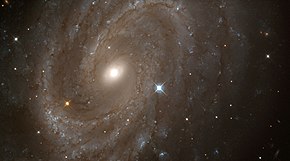
Summary
NGC 4603 is a spiral galaxy located about 107[2] million light years away in the constellation Centaurus. It is a member of the Centaurus Cluster of galaxies, belonging to the section designated "Cen30". The morphological classification is SA(s)c,[4] which indicates it is a pure spiral galaxy with relatively loosely wound arms.[5]
| NGC 4603 | |
|---|---|
 A Hubble Space Telescope (HST) image of NGC 4603. | |
| Observation data (J2000 epoch) | |
| Constellation | Centaurus |
| Right ascension | 12h 40m 55.195s[1] |
| Declination | –40° 58′ 35.05″[1] |
| Heliocentric radial velocity | +2561[2] km/s |
| Distance | 106.8 Mly (32.71 Mpc)[2] |
| Apparent magnitude (V) | 12.3[3] |
| Characteristics | |
| Type | SA(s)c |
| Size | 100,000 ly (diameter) |
| Apparent size (V) | 3′.4 × 2′.5[3] |
| Other designations | |
| PGC 42510[3] | |
During 1999, this galaxy was the subject of an extended study using the Hubble Space Telescope to locate Cepheid variable stars. A total of 43±7 were found, and the measurement of their periodicity gave a net distance estimate of 108.7+5.5
−4.9 Mly (33.3+1.7
−1.5 Mpc). This is consistent with the distance estimate determined through redshift measurements. As of the time of this study, NGC 4603 was the most distant galaxy for which a distance estimate had been made using Cepheid variable.[6]
On May 21, 2008, supernova SN 2008cn was discovered at a position 23.″2 north and 4.″7 east of the galaxy center. It was determined to be a high-luminosity Type II-P supernova, with a progenitor tentatively identified as a red supergiant with 15 ± 2 solar masses. Based upon the yellowish color, it may have been a member of a binary star system.[7]
References edit
- ^ a b Skrutskie, Michael F.; Cutri, Roc M.; Stiening, Rae; Weinberg, Martin D.; Schneider, Stephen E.; Carpenter, John M.; Beichman, Charles A.; Capps, Richard W.; Chester, Thomas; Elias, Jonathan H.; Huchra, John P.; Liebert, James W.; Lonsdale, Carol J.; Monet, David G.; Price, Stephan; Seitzer, Patrick; Jarrett, Thomas H.; Kirkpatrick, J. Davy; Gizis, John E.; Howard, Elizabeth V.; Evans, Tracey E.; Fowler, John W.; Fullmer, Linda; Hurt, Robert L.; Light, Robert M.; Kopan, Eugene L.; Marsh, Kenneth A.; McCallon, Howard L.; Tam, Robert; Van Dyk, Schuyler D.; Wheelock, Sherry L. (1 February 2006). "The Two Micron All Sky Survey (2MASS)". The Astronomical Journal. 131 (2): 1163–1183. Bibcode:2006AJ....131.1163S. doi:10.1086/498708. ISSN 0004-6256. S2CID 18913331.
- ^ a b c Crook, Aidan C.; et al. (February 2007), "Groups of Galaxies in the Two Micron All Sky Redshift Survey", The Astrophysical Journal, 655 (2): 790–813, arXiv:astro-ph/0610732, Bibcode:2007ApJ...655..790C, doi:10.1086/510201, S2CID 11672751.
- ^ a b c "NASA/IPAC Extragalactic Database". Results for NGC 4603. Retrieved 2007-04-01.
- ^ Martínez-García, Eric E.; González-Lópezlira, Rosa A. (March 2013), "Signatures of Long-lived Spiral Patterns", The Astrophysical Journal, 765 (2): 105, arXiv:1301.6634, Bibcode:2013ApJ...765..105M, doi:10.1088/0004-637X/765/2/105, S2CID 119245715.
- ^ Buta, Ronald J.; et al. (2007), Atlas of Galaxies, Cambridge University Press, pp. 13–17, ISBN 978-0521820486.
- ^ Newman, Jeffrey A.; et al. (October 1999), "A Cepheid Distance to NGC 4603 in Centaurus", The Astrophysical Journal, 523 (2): 506–520, arXiv:astro-ph/9904368, Bibcode:1999ApJ...523..506N, doi:10.1086/307764, S2CID 15343736.
- ^ Elias-Rosa, Nancy; et al. (December 2009), "On the Progenitor of the Type II-Plateau SN 2008cn in NGC 4603", The Astrophysical Journal, 706 (2): 1174–1183, arXiv:0910.2275, Bibcode:2009ApJ...706.1174E, doi:10.1088/0004-637X/706/2/1174, S2CID 27405656.
External links edit
- Media related to NGC 4603 at Wikimedia Commons


